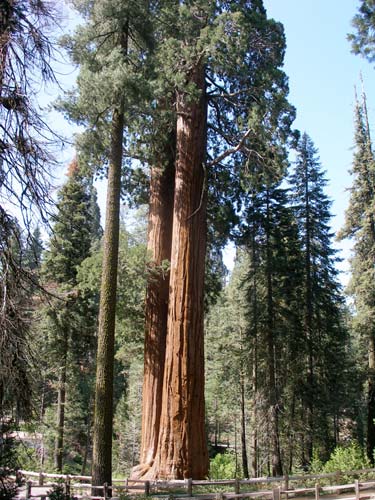
Lower branches die fairly easily from a lack of sunlight. This happens mostly in thick groves. Solitary trees will keep their lower branches.

Trees that are under 100 years old will still have their dead lower branches.

In general, sequoias are fire-resistant but will burn if subjected to prolonged fire that is fueled by other trees or forest matter.

Charred outer bark

The Vermont log was 246 feet long and 16 feet in diameter at chest height. It fell in 1985.

A Golden-mantled ground squirrel stops by for a quick visit.


In comparison is this chipmunk. It is a lot smaller than the ground squirrel and has eye stripes.

In general, giant sequoias are very hardy. Their bark is resistant to fire and few insects and diseases can cause them harm. Their roots, however, are quite shallow (most growing no deeper than 5 feet beneath the surface). Toppling is the therefore primary way these trees meet their end... either from heavy snow, strong winds, or a weakened support from soil fungi and insects.

The thick bark


The Kentucky Tree has an 18-foot diameter at chest height.
In the early days, many of the giant sequoias were named after states. Only a few of the names survive because most were never properly recorded. Today the practice of naming trees has been discontinued.

The Delaware Tree has a 14-foot diameter at chest height.

The Lightning Tree is a double tree. Most of the left tree has been consumed by fire. Fires burning between closely growing trees create an oven effect, increasing the temperature of the fire.

The Oregon Tree has a 21-foot diameter at chest height.

In 1967, the California Tree was struck by lightning. The top 25 feet of the tree shattered and caught on fire. Due to its close proximity to the trail, the Park Service decided that the smoke, burning embers and possible falling branches were a safety hazard. Park forester Charlie Castro climbed the fir tree next to it, swung over to the sequoia, then climbed to a spot where he could extinguish the fire with a hose. If the fire had not been put out, it could have burned for weeks inside the tree.

Heading toward the Lincoln Tree

The Lincoln Tree has a large base, but its trunk tapers too much to make it one of the world's largest.

Eventually we find ourselves back at the Twin Sisters, two trees that have fused together.